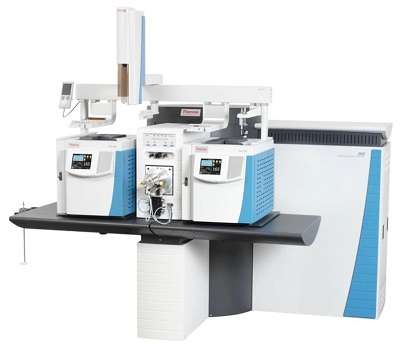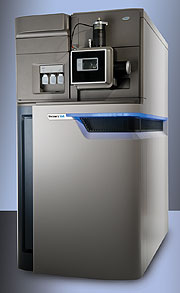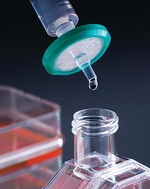Mass Spectrometry Facility
Facility Manager
Aruni (Chathu) Pulukkody519-661-2111 ext. 86323
apulukko@uwo.ca
Instrumentation
Thermo Scientific DFS (Double focusing Sector) - Out of service until further notice
 Samples can be analyzed using two modes of ionization
Samples can be analyzed using two modes of ionization
- Electron impact (EI)
- Chemical ionization (CI) (please contact the facility manager for availability)
A resolution of > 60000 (at 10% valley) can be achieved on the instrument. The DFS has a mass range of 0-1200 m/z at full acceleration and up to 6000 m/z at reduced acceleration.
Bruker micrOTOF 11
Samples can be analyzed using electrospray ionization (ESI) through direct infusion. It has a variety of applications such as small molecules, accurate mass determination (HRMS) along with intact proteins and peptides. The instrument have a mass range 60 -20,000 m/z.Waters Synapt HDMS (High Definition Mass Spectrometer)
 The instrument is a hybrid, quadrupole/ion mobility/orthogonal acceleration time-of-flight (oaTOF) mass spectrometer.
The instrument is a hybrid, quadrupole/ion mobility/orthogonal acceleration time-of-flight (oaTOF) mass spectrometer.- This system combines exact mass with lock mass correction, high resolution and ion mobility separation (IMS).
- Samples can be analyzed using electrospray ionization (ESI) through direct infusion.
Shimadzu GCMS-QP2010 (Decommissioned)
The instrument is a benchtop gas chromatograph/ quadrupole mass spectrometer for high precision GC/MS analysis. The instrument is ideal for qualitative sample analysis and identification of unknowns or for the quantitation of trace constituents. The Shimadzu GCMS-QP2010 is an electron impact (EI) only instrument and has a mass range 10 -1000 m/z, and uses a Shimadzu AOC-20i auto-injector for automated sample injecting.Protocols used for sample submission and preparation
Sample submission
When you need to submit a sample, please contact the facility manager about the time and availability. Be sure to fill out the sample submission form with all the details including account number, sample code, concentration, suitable solvent, chemical formula and accurate mass.
- Please pickup your sample from the facility once you receive the results.
- Please let the facility manager know if there any special conditions or precautions that must be taken during sample analysis.
- Training can be available for all instruments except Bruker microOTOF 11.
- Some services like ion mobility mass spectrometry and tandem mass spectrometry require special arrangement and different sample rate (please contact the facility manager: hmetwal4@uwo.ca)
- Never use mineral acids like HCl or sulfuric acid which can damage stainless steel instrument components.
- The samples from outside of the department have different rates, please contact the facility manager.
Sample preparation for ESI
- The concentration of analyte in the range 0.5-1 milligram per mL (non-protein or peptides) that will be further diluted by operator. Please make sure that there are no hard particles in the solution or any precipitation in your vial and the solution must not be cloudy. If a precipitation happened, filter your sample to avoid blockages and contaminations inside the mass spectrometer.

- All instruments use electrospray ionization are only compatible with volatile organic solvents (MeOH, ACN and water. Samples have to be cleaned of inorganic salts and in-soluble buffers.
- Please do not use low vapor pressure solvents, such as DMSO. Just dilute them into MeOH or ACN.
- Do not use trifluoroacetic acid (TFA) in your samples. If you need to acidify your samples use formic acid.
- Concentration of protein should be 1-10 uM in either buffered solution with ammonium acetate/ ammonium formate or MeOH/H2O, MeOH only with/without 0.1% formic acid.
- Over concentrated samples lead to increased chemical noise, poor mass resolution, blockage in the sample delivery lines and contamination of the mass spectrometer vacuum part.
Sample preparation for the direct insertion probe (Thermo DFS)
- All samples should be soluble in volatile solvents having a concentration of 0.5-1 ug/ul. The samples must be of high purity.
- Please provide the temperature range (boiling point) that the sample can be analyzed with.
Sample preparation for GCMS
- Please specify the GC temperature program and the injector temperature and the type of column (I only have a single good column).
- Determine whether the injection is split/ splitless, and the solvent for needle wash.
- All samples should be soluble in high purity volatile solvents- non polar solvents are preferred having a concentration of 0.001-0.1 mg/ml, never exceed 0.5mg/ml as this will damage the column. The samples must be of high purity.
Useful Links
Molecular mass calculator: ChemCalc: molecular formula information
Mass calculations: mass error and m/z from formula (warwick.ac.uk)
Online MS Tools for Mass Spec Users (sisweb.com)
How electrospray works: New Objective : Innovation in High-Performance LC-MS
The Difference between resolution and mass accuracy: Slides (agilent.com)
Contamination database in ESI: MaConDa - Mass spectrometry Contaminants Database (bham.ac.uk)
Common background ions in ESI: ESI Background Ions (waters.com)
DFS™ Magnetic Sector GC-HRMS System (thermofisher.com)
Assigning the ESI mass spectra of organometallic and coordination compounds (uvic.ca) – a tutorial
Isotope Distribution Calculator, Mass Spec Plotter, Isotope Abundance Graphs (sisweb.com)

